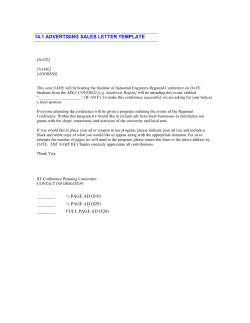
seeking corporate sponsorship
seeking corporate sponsorship Corporate sponsorship can provide a vital source of funding. To secure sponsorship you need to understand what sponsors are looking for and offer benefits and value that meet their needs. Sponsorship is a business relationship that does not end when you receive the money—you need to work hard to ensure that sponsors obtain the benefits they sought. what you need to know do sponsorship arrangements have to be exclusive? Some sponsors may prefer an exclusive arrangement, but there is nothing to prevent you from having multiple sponsors. If you do work with more than one sponsor, it may be preferable to have tiered levels of sponsorship with different benefits for different contributions. clarify why you need sponsorship Sponsorship can take many different forms, so it is important to analyze what type of benefits you want from the sponsorship arrangement. These are some of the more common forms of sponsorship or support. Funding provides you with money that can cover your challenge costs. It is the most flexible form of sponsorship. Discounted or free goods or services—this type of sponsorship can help you reduce your challenge costs for example seeking clothing or equipment, flights or insurance. Donations provide you with money for any suitable purpose. Donations offer flexibility, but, in most cases, the donor does not require anything in return. understand sponsors’ needs Sponsors do not provide funds because they feel benevolent. They have a number of marketing and corporate objectives that sponsorship can help them to meet. When you are seeking sponsorship for your organization, it is important to understand the drivers which include: selling more product by increasing the visibility of their brand; raising their profile by association with your challenge; improving their corporate image by involvement in appropriate activities; meeting corporate responsibilities by supporting good causes; achieving product endorsement through association with a successful event/participant; hospitality opportunities by inviting clients to high profile events run by you; improving employee relations through hospitality or association with a high-profile challenge; improving media coverage (within the company (employees, shareholders), the sector they are in (suppliers, customers) and of course externally (to the public and media). assess your value to sponsors Before you approach prospective sponsors, you should look closely at yourself and your challenge to identify the potential benefits for a sponsor. Key factors could include: your previous track record; your reputation for excellence; the strength of your identity; your community involvement; the facilities you could offer the sponsor; co-marketing opportunities. the charity you are aligning your challenge with identify a suitable sponsor Sponsorship can come from a number of sources, including businesses or individuals. If you are looking for corporate sponsors, draw up a short list of businesses with characteristics such as: companies that have a connection with yourself, the charity you are supporting or the challenge (geography, activity, level of difficulty, skills required during the challenge); local businesses that could benefit from an association with yourself or the challenge; national companies who sponsor similar events or the charity you are supporting. Your preliminary approach should be based on an introductory letter and a sponsorship proposal that is tailored to each prospect. The letter should be addressed to a named individual and should seek to secure an appointment for more detailed discussions. prepare a proposal The sponsorship proposal should be informative and should set out precisely what you require and what you are offering the sponsor. As a guideline, the proposal should be roughly four pages long and should provide details of yourself, the challenge, and the charity you are supporting as well as details of sponsorship opportunities. The information should include: you age, sex, where you are based, who you work for if appropriate previous achievements and successes previous sponsors endorsements and testimonials press coverage achieved previously or to date on your new challenge other funding sources you have achieved or are waiting for feedback from purpose of sponsorship the challenge you are intending to embark upon your goals and objectives from the challenge the charity you are supporting how you will use the sponsorship funds time frame for the challenge key benefits of the challenge financial projections benefits to the sponsor Specific benefits tailored to the individual prospect, including: association with yourself and your reputation; association with supporting the charity links to the challenge key attributes required during the challenge that might resonate with the company’s own ethos, such as strength or character, determination, teamwork and so on. Copyright free use of images and stories from you during your challenge operation of sponsorship This section should explain what the sponsor will receive in terms of coverage and facilities, such as: exclusive sponsorship or shared benefits; identification and acknowledgement of the sponsor by name and logo; acknowledgement on promotional material and other documentation; planned media coverage, including sponsorship announcement and any special events; prominence on your Web Site (if applicable); hospitality facilities such as free tickets and opportunities for client entertainment at any other fundraising events. write a personalized cover letter The cover letter should be personalised to each prospective sponsor and should highlight the reason for the approach. It should highlight the potential synergy between you and the sponsor and demonstrate that you understand the sponsor’s business needs. You should conclude the letter by saying that you will be in touch shortly to arrange a meeting. If you want the prospect to respond, offer alternatives such as a telephone number or e-mail address to make it easy to reply. It’s normally best to keep the next move within your court. follow up the proposal If you stated that you would contact the prospect, make sure you do so within the time frame you indicated. If you are successful, arrange a meeting to discuss the sponsorship in more detail. If the prospect turns you down, you should try to find out why your bid was not successful, so that you can fine-tune any future proposals. announce the successful sponsorship Once you have secured a sponsor, announce the fact in the press to get the first level of coverage. If you are planning an official launch, invite journalists and reporters to the event. You should send your release to your own local newspapers, radio, and television stations, as well as any media that are relevant to your sponsor’s business (trade press). You should also announce the arrangement on your website and contact any other interested parties by e-mail or mail. help to raise your sponsor’s profile Sponsorship, like any other marketing medium, should be measured. The sponsor will be looking for a good return on investment. Although it might be hard to track tangible benefits, such as increased sales, the metrics are more likely to focus on intangibles such as levels of press coverage, changes in attitude or awareness levels among key target groups. You can help your sponsor achieve success by promoting its involvement whenever possible. As well as using your sponsor’s name and logo on any relevant communications material, you may be able to plan special events featuring your sponsor’s products or services. encourage networking If you have arrangements with a number of sponsors who have mutual interests, you can create further benefit by enabling the different parties to network. You can do this by arranging informal meetings or inviting all parties to any sponsorship-related events. provide feedback to your sponsor Good sponsorship arrangements are based on effective long-term relationships. You can strengthen the relationship by providing feedback on the results of the sponsorship. This might include: copies of press releases and press cuttings featuring the sponsor; reports on the number of visits to your website; progress reports on the sponsored project; details of upcoming events. As part of the feedback process, you should arrange regular review meetings with your sponsor to ensure that the arrangement continues to benefit both parties. Is the sponsorship package enabling you to meet your objectives? Do the arrangements impose any restrictions that are detrimental to you or the challenge? Has there been any adverse reaction to the arrangements? Is the sponsor satisfied with the level of coverage? Is the sponsor meeting its own objectives? what to avoid you put together a poor proposal Sponsorship is a business arrangement. Therefore, it is essential to put together a professional proposal that provides potential sponsors with all the information they need to make a decision. The proposal should demonstrate an understanding of the sponsor’s business and needs, and the content should be tailored to individual prospects. you target the wrong prospects The best sponsorship deals provide a close match between you and the sponsor. The match could be based on a common target audience, shared values, or other factors. Preliminary research should concentrate on identifying prospective sponsors who offer the greatest potential for a match. If you do choose the wrong sponsor, the arrangement may not produce benefits for either party.
© Copyright 2025





















